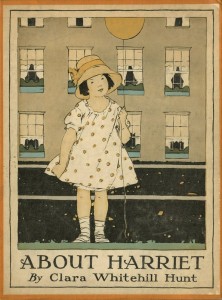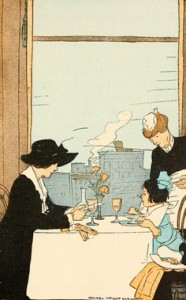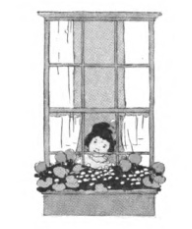© Copyright 2014 Jessica Almeida, Ryerson University

Introduction:
About Harriet is a medium-sized children’s book that includes a 152 pages of descriptions and pictures of a child named Harriet’s daily encounters and activities. Clara Whitehill Hunt, who was a teacher, librarian, author and supporter for children’s library services, wrote About Harriet. Maginel Wright Enright, who was an illustrator for children’s books and magazines, illustrated the pictures displayed throughout About Harriet. Houghton Mifflin Company and The Riverside Cambridge in Boston and New York respectively published About Harriet. This children’s book can be found in the Children’s Literature Archive Collection. Published in November 1916, About Harriet was read to children during the First World War. At this point the United States had not yet joined the war, but the fear of the American entrance was amongst the American citizens.
Hunt was well known for writing children’s books that focused on the positive rather than the negative. Knowing that the First World War was taking place, Hunt wrote About Harriet during a time when the world was at war to promote a positive atmosphere and peace. Hunt believed that it is careless to let children waste their time reading books with weak stories. Although they may have a strong storyline they lack the broadening of young minds and hearts, which Hunt believed a good children’s book should do.
The war can be scary for children who may not understand it, but books such as About Harriet can be used to reduce that fear and try to promote to children the idea that no matter what is going on in the world it’s important to stay positive and have a good outlook on life. The critical approach I will be taking when analyzing About Harriet will be focusing on Hunt’s use of children’s books to promote positive attitudes and good behaviour towards people. Children’s books have a substantial amount of influence on young minds and if we promote positive behaviour in our children’s books, the future could be without war.
Summary
About Harriet is a fascinating children’s book recommended for ages four to eight. This children’s book revolves around the endeavors of a young four-year-old girl who lives with her mother and father in the city throughout all the seven days of the week. There are also visually enjoyable illustrations that give graphics to Harriet’s daily actions.
This children’s book touches upon issues that families would go through on a daily bases and displays the way children should behave and act in each situation. By reading this children’s book, children should learn how to behave well and act in a well-mannered way. The story is divided into seven chapters that resemble the seven days of the week and tells the story of what she did on that day.
The story begins on a Friday morning where Harriet wakes up and helps her mother do chores around the house. For example she helps her mother wash dishes, bake and iron clothes. Then Harriet and her mother go to park where Harriet is confronted with dangerous situations in which she knows to avoid in order to be safe.
The weekend is spent at the beach with her family, which is where Harriet makes a new friend. Harriet also goes to church, which shows the importance of religion and morality. The events that took place over the weekend introduce the importance of family and religion to the young impressionable children who are reading this book.
The remaining of the week revolves around Harriet and the series of events that her mother and herself engage in while her father is out at work. Events that took place include spending a day indoors because of horrible weather conditions, visits from various family members, going to the grocery store and spending the day downtown shopping and going to a fancy restaurant for dinner. Each event involved a well behaved young girl, who not once misbehaved.

This idea of a well-behaved young girl changed on Thursday. Harriet isn’t as behaved as he had been all week and her mother is not happy with her behaviour. She tells her mother that the reason why she is behaving naughtily is because of the book she had read, in which one of the characters was being naughty because they woke up on the wrong side of the bed. Harriet realizes that she is behaving naughty and apologizes to her mother. She tells her mother that she enjoys books of good people rather than books of naughty people. After her nap, they go to the library. Hunt includes the act of going to the library to show the significance of libraries and how important they are for children to visit. When they get home they play a game that makes Harriet realize that she will never be naughty again like she was that morning.
To end the story by having a day that is different than the others makes children realize that when you are a good person you do a lot more activities than when you are naughty. The moral of the story being that you should always be well behaved and never act mischievous. Essentially this children’s book promotes good behaviour in hopes that children will not act naughty and therefore there will be more peace in the world.
Production and Reception
The Riverside Cambridge and Houghton Mifflin Company published About Harriet. Henry Houghton originally started The Riverside Cambridge and in 1872, he entered a partnership with George Mifflin, thus creating the Houghton Mifflin Company (Dornbusch).
About Harriet was published a year before the United States entered World War One. Although it can be argued that Hunt wrote About Harriet with the possibility of America entering the war in mind, she wrote a book about a child that learns it is better to be good than bad in hopes that positive reinforcement of good behaviour would prevent future wars. Hunt believed that if a book promoted peace, there would less likely be future wars. This belief explains the production of About Harriet.
During this time period a lot of books about war were being published. About Harriet differed from most of the books because fighting and war were not included in Hunt’s children’s book. A month after About Harriet was published, it was advertised in the New York Sun under a listing of other children’s book that were also being published by the Houghton Mifflin Company. At the time About Harriet’s net price was $1.25. The book was well liked amongst parents and their children and was a favourite pick by children at bedtime.
The Purpose of Children’s Books During the First World War
America’s Entrance
Three years after World War One began, President Thomas Woodrow Wilson believed there was no alternative to war and declared America’s entrance in to the war in 1917. The Germans were the main reason for America’s entrance because of unrestricted submarine warfare. America’s ships were being bombed, leading to American merchant seaman and civilians being killed. This affected the American economy and caused the United States to join the Allies and invest a lot of money in them. America believed that the only way to protect America’s financial investments was to join the war in hopes of a victory (Clements).
The entrance of America into the First World War instilled fear into many American citizens. While soldiers were preparing for war, parents at home were either worrying about their son fighting in a war or figuring out how they were going to explain to their children about what was going on in the world. This was seen as a prime time for the introduction of children’s books on war. These books would give parents the materials they need in order to educate their children on what was happening.
Children’s Books on War
During war, it is not just the soldiers and citizens who suffer; children do too, even those who are not directly involved. Even if the child is not directly affected by the war physical or mentally, just simply worrying about the war can have a negative effect on children (Crowe).
How can children’s books on war be beneficial? Reading about war can lead to peace because today’s children are tomorrow’s adults. This idea of peace will benefit future generations. Good children’s books about war can inspire children to appreciate the sense of peace and realize the terror of war (Crowe). This inspiration can influence the children to cherish peace and promote it in order to prevent future wars.
Sustaining peace is not easy, but by having children’s books present the idea of peace reinforces that war can be avoided when people start to realize that foreigners and potential enemies are human just like they are (Crowe). Enforcing positive messages in children’s books can help create a brighter.

The Message Behind Hunt’s About Harriet
Clara Whitehil Hunt was best known for her work with children’s literature services. When she thought about war only one word came to mind and that was ‘selfishness’. She explains this selfishness as wanting the power to control the minds and souls of men. She believed that the only way to get rid of war was to change human nature. A person’s human nature is a reflection of how they were brought up. If a child was told at a young age that it is important to fight for your country and it is your duty to, the child will grow up believing that you have no other choice but to join the army and fight in the war (Hunt). Therefore the only way to change human nature is to make sure children are being surrounded by positive behaviour. This is where Hunt believes children’s books are effective.
About Harriet involves a girl who behaves well, has perfect manners and never misbehaves. It is only on the last day of the week she decided to misbehave and mimic a behaviour she read in a book. However, this changes when Harriet quickly realizes that being bad is unacceptable and that it is better to be good than bad. Hunt includes this moral to educate children to always behave and that it’s better to be good than bad.
This moral also teaches parents that what their children reads influences the way that they behave. Harriet is around the same age as the children who are reading this book or who are having this book read to them, which allows the child to relate to Harriet. Children start to think that if he or she behaves well they will do all the exciting activities Harriet does. If everyone is good rather than bad it makes for a better world. Bad behaviour can create hate towards other people, which can lead to war. Hunt wants parents to read About Harriet to their children to promote positive behaviour, thus creating well-behaved children. Children believe what they have been taught by their elders.
Conclusion
Hunt states that we cannot afford to let children grow up without good books to read (Hunt). It is important to have these books available for children to read because the war can cause a lot of chaos, but with the help of positive reinforcement from children’s books there is hope for no future wars. Children are the future and it is up to today’s adults to make sure they have all the knowledge they need to create a world they would want to live in.
Link to About Harriet by Clara Whitehill Hunt
Works Cited
Clements, Kendrick A. “Woodrow Wilson and World War I.” Presidential Studies
Quarterly 34.1 (2004): 62–82. Project Muse. Web. 20 Feb. 2014
Crowe, Chris. “Peace-Keeping Forces: YA War Books.” English Journal, High school
edition 89.5 (2000): 159–163. Project Muse. Web. 20 Feb. 2014
Dornbusch, Erin. “Riverside Press”. Industry in Cambridge. Web. 19 Feb. 2014
Hunt, Clara Whitehill. About Harriet. Illus. Maginel Wright Enright. Boston and New
York: Hougton Mifflin Company and The Riverside Cambridge, 1916. Children’s Literature Archive, Ryerson University. Print. –Link to the CLA Catalogue
Hunt, Clara Whitehill. “The Child and the Book in War Times.” The English Journal 7.8 (1918): 487–496. JSTOR. Web. 19 Feb. 2014.
“Just the Books For Boys and Girls From the List of Houghton Mifflin Company.” The
New York Sun 2 December 1916. Web. 20 Feb. 2014




